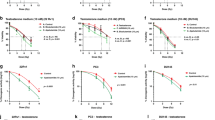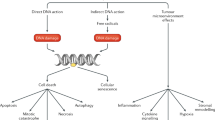Abstract
A targeted radiotherapy/gene therapy approach for prostate cancer, using the radiopharmaceutical [131I]meta-iodobenzylguanidine ([131I]MIBG), would restrict the effects of radiotherapy to malignant cells, thereby increasing efficacy and decreasing morbidity of radiotherapy. Prostate cancer cells were transfected with a transgene encoding the noradrenaline transporter (NAT) under the control of tumour-specific telomerase promoters, enabling them to actively take up [131I]MIBG. This led to tumour-specific cell kill. This strategy has the advantage of generating a radiological bystander effect, leading to the destruction of neighbouring tumour cells that have escaped transfection. This targeted approach could be a promising tumour-specific treatment option for prostate cancer.
This is a preview of subscription content, access via your institution
Access options
Subscribe to this journal
Receive 4 print issues and online access
$259.00 per year
only $64.75 per issue
Buy this article
- Purchase on Springer Link
- Instant access to full article PDF
Prices may be subject to local taxes which are calculated during checkout







Similar content being viewed by others
References
Weir HK et al. Annual report to the nation on the status of cancer, 1975–2000, featuring the uses of surveillance data for cancer prevention and control. J Natl Cancer Inst 2003; 95: 1276–1299.
Duchesne GM . Radiation for prostate cancer. Lancet Oncol 2001; 2: 73–81.
Peschel RE, Colberg JW . Surgery, brachytherapy, and external-beam radiotherapy for early prostate cancer. Lancet Oncol 2003; 4: 233–241.
Marks LB, Carroll PR, Dugan TC, Anscher MS . The response of the urinary bladder, urethra, and ureter to radiation and chemotherapy. Int J Radiat Oncol Biol Phys 1995; 31: 1257–1280.
Gaze MN, Wheldon TE . Radiolabelled mIBG in the treatment of neuroblastoma. Eur J Cancer 1996; 32A: 93–96.
Troncone L, Rufini V . 131I-MIBG therapy of neural crest tumours (review). Anticancer Res 1997; 17: 1823–1831.
Mukherjee JJ et al. Treatment of metastatic carcinoid tumours, phaeochromocytoma, paraganglioma and medullary carcinoma of the thyroid with 131I-meta-iodobenzylguanidine ([131I]MIBG). Clin Endocrinol (Oxf) 2001; 55: 47–60.
Boyd M et al. Noradrenaline transporter gene transfer for radiation cell kills by [131I]metaiodobenzylguanidine. Gene Therapy 1999; 6: 1147–1152.
Boyd M et al. A gene therapy/targeted radiotherapy strategy for radiation cell kill by [131I]metaiodobenzylguanidine. J Gene Med 2001; 3: 165–172.
Mairs RJ, Cunningham SH, Boyd M, Carlin S . Applications of gene transfer to targeted radiotherapy. Cur Pharm Des 2000; 6: 1419–1432.
Boyd M et al. Expression in UVW glioma cells of the noradrenaline transporter gene, driven by the telomerase RNA promoter, induces active uptake of [131I]MIBG and clonogenic cell kill. Oncogene 2001; 20: 7804–7808.
Plumb JA et al. Telomerase specific suicide gene therapy vectors expressing bacterial nitroreductase sensitise human cancer cells to the pro-drug CB1954. Oncogene 2001; 20: 7797–7803.
Sommerfeld HJ et al. Telomerase activity: a prevalent marker of malignant human prostate tissue. Cancer Res 1996; 56: 218–222.
Lin Y et al. Telomerase activity in primary prostate cancer. J Urol 1997; 157: 1161–1165.
Shay JW, Bacchetti . A survey of telomerase activity in human cancer. Eur J Cancer 1997; 33: 787–791.
Kim NW, Hruszkewycz AM . Telomerase activity modulation in the prevention of prostate cancer. Urology 2001; 57 (Suppl. 4A): 148–153.
Orlando C, Gelmini S, Selli C, Pazzagli M . Telomerase in urological malignancy. J Urol 2001; 166: 666–673.
Orlando C, Gelmini S . Telomerase in endocrine and endocrine-dependent tumours. J Steroid Biochem Mol Biol 2001; 78: 201–214.
Essand M, Groenvik C, Hartman T, Carlsson J . Radioimmunotherapy of prostatic adenocarcinomas: effects of 131I-labelled E4 antibodies on cells at different depth in DU 145 spheroids. Int J Cancer 1995; 6: 387–394.
Ballangrud AM et al. Growth and characterization of LNCaP prostate cancer cell spheroids. Clin Canc Res (Suppl) 1999; 5: 3171s–3176s.
Hedlund TE, Duke RC, Miller GJ . Three-dimensional spheroid cultures of human prostate cancer cell lines. Prostate 1999; 41: 154–165.
Boyd M et al. Transfectant mosaic spheroids: a new model for evaluation of bystander effects in experimental gene therapy. J Gene Med 2002; 4: 1–10.
Cunningham S et al. A gene therapy approach to enhance the targeted radiotherapy of neuroblastoma. Med Pediatr Oncol 2000; 35: 708–711.
Steiner MS, Gingrich JR . Gene therapy for prostate cancer: where are we now? J Urol 2000; 164: 1121–1136.
Maitland NJ . Targeting therapeutic gene expression to human prostate cancers. Curr Opin Mol Ther 2000; 2: 389–399.
Koeneman KS, Hsieh J-T . The prospect of gene therapy for prostate cancer: update on theory and status. Curr Opin Urol 2001; 11: 489–494.
McKenzie KE, Umbricht CE, Saraswati S . Applications of telomerase research in the fight against cancer. Mol Med Today 1999; 5: 114–122.
Urquidi V, Tarin D, Goodison S . Role of telomerase in cell senescence and oncogenesis. Ann Rev Med 2000; 51: 65–79.
Keith WN, Evans TRJ, Glasspool RM . Telomerase and cancer: time to move from a promising target to a clinical reality. J Pathol 2001; 195: 404–414.
Boyd M et al. An efficient targeted radiotherapy/gene therapy strategy utilising human telomerase promoters and radioastatine and harnessing radiation mediated bystander effects. J Gene Med 2004; 6: 937–947.
Spitzweg C et al. Prostate-specific antigen (PSA) promoter-driven androgen-inducible expression of sodium iodide symporter in prostate cancer cell lines. Cancer Res 1999; 59: 2136–2141.
Lee SE et al. Development of a new plasmid vector with PSA-promoter and enhancer expressing tissue-specificity in prostate carcinoma cell lines. Anticancer Res 2000; 20: 417–422.
Djordjevic B . Bystander effects: a concept in need of clarification. BioEssays 2000; 22: 286–290.
Belyakov OV et al. Direct evidence for a bystander effect of ionising radiation in primary human fibroblasts. Br J Cancer 2001; 84: 674–679.
Hall EJ . The bystander effect. Health Phys 2003; 85: 31–35.
Wheldon TE, O'Donoghue JA, Barrett A, Michalowski AS . The curability of tumours of differing size by targeted radiotherapy using 131I or 90Y. Radiother Oncol 1991; 21: 91–99.
Gaze MN et al. [131I]meta-iodobenzylguanidine therapy in neuroblastoma spheroids of different sizes. Br J Cancer 1992; 66: 1048–1052.
Cunningham SH et al. Toxicity to neuroblastoma cells and spheroids of benzylguanidine conjugated to radionuclides with short-range emissions. Br J Cancer 1998; 77: 2061–2068.
Allen BJ . Targeted alpha therapy: Evidence for potential efficacy of alpha-immunoconjugates in the management of micrometastatic cancer. Australas Radiol 1999; 43: 480–486.
Zalutsky MR, G . Astatine-211-labeled radiotherapeutics: an emerging approach to targeted alpha-particle radiotherapy. Curr Pharm Des 2000; 6: 1433–1455.
Imam SK . Advancements in cancer therapy with alpha-emitters: a review. Int J Radiat Oncol Biol Phys 2001; 51: 271–278.
Jurcic JG et al. Targeted α particle immunotherapy for myeloid leukaemia. Blood 2002; 100: 1233–1239.
Acknowledgements
This project was supported by the British Urological Foundation (BUF/Sanofi-Synthelabo Scholarship 2001/2002) and by the Royal College of Physicians and Surgeons of Glasgow (Ian Sunter Charitable Trust Research Fellowship 2003). Additional funding was obtained from CR UK, Glasgow University School for Cancer Studies, NHS Scotland and the Urology Cancer Urology Cancer Research Fund 1122, Gartnavel General Hospital, Glasgow. We thank Amersham for providing [131I]MIBG.
Author information
Authors and Affiliations
Corresponding author
Rights and permissions
About this article
Cite this article
Fullerton, N., Boyd, M., Mairs, R. et al. Combining a targeted radiotherapy and gene therapy approach for adenocarcinoma of prostate. Prostate Cancer Prostatic Dis 7, 355–363 (2004). https://doi.org/10.1038/sj.pcan.4500760
Received:
Accepted:
Published:
Issue Date:
DOI: https://doi.org/10.1038/sj.pcan.4500760
Keywords
This article is cited by
-
Extraction chromatographic behavior of actinium and REE on DGA, Ln and TRU resins in nitric acid solutions
Journal of Radioanalytical and Nuclear Chemistry (2015)



